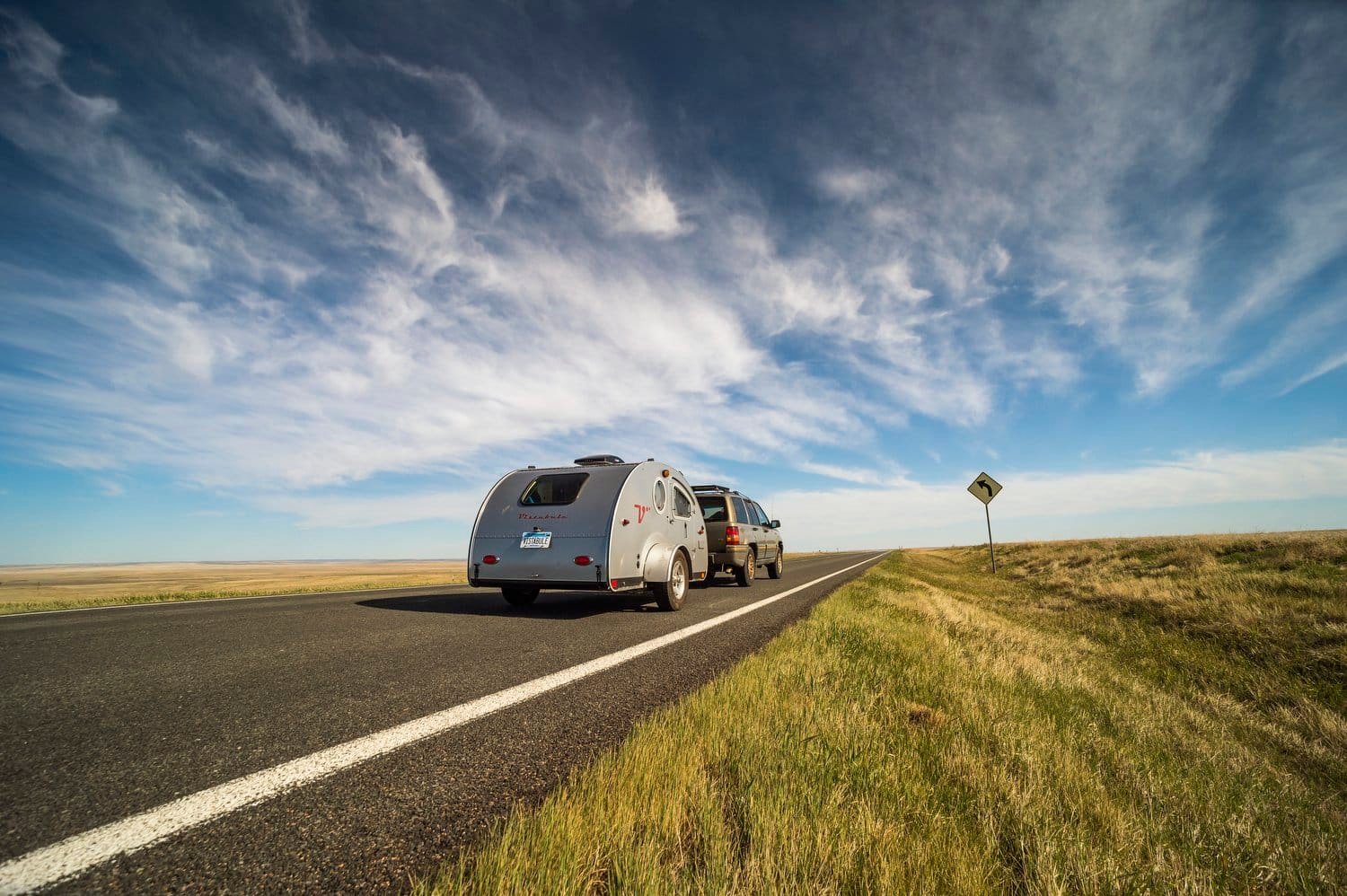Whether you’re a camping pro or want to learn more about the joys of owning an RV, there are a lot of details to consider, especially the weight of your teardrop camper.
This guide will help you learn about the weight of teardrop trailers and how to tow one behind your vehicle. That way you can travel safely and with confidence.
Use the links below to jump to a specific section on the page.

Weight plays a big part in considering a teardrop trailer.
How Much Do Teardrop Trailers Weigh?
We design teardrop trailers to provide the greatest amount of comfort in a small amount of space. They weigh only one to two tons, on average. This lightweight layout makes them towable by almost any vehicle with a hitch. Even motorcycles and bicycles, in some cases.
Average Travel Trailer Weights
Want to know how we reached our average range? We looked at teardrop trailers from well-known manufacturers throughout the country:
Vistabule Teardrop Trailer Weight
- Dry Weight: 1,330 lbs.
- Gross Weight: 2,200 lbs.
Vistabule offers a lightweight teardrop trailer option, weighing 1,330 pounds, dry. Even with fully-loaded features, these campers are still lighter than many other models on the market. We placed special care on its aerodynamic design and perfectly balanced axle. It pulls smoothly behind almost any car, SUV, truck, or other vehicle.

Starting at 1,330lbs, towing a Vistabule is a cinch for a wide variety of vehicles.
Meerkat Teardrop Trailer Weight
- Dry Weight: 880 lbs.
- Gross Weight: 2,000 lbs.
If there was a featherweight division in the RV world, Meerkat’s CampKat would be a title contender. At 880 lbs., this camper is a good choice for those looking for a stripped-down, hassle-free option. With add-on features, you can tailor your trailer’s weight and comfort.
Taxa Outdoors Teardrop Trailer Weight (specify model – TigerMoth)
- Dry Weight: 1,800 lbs.
- Gross Weight: 2,500 lbs.
One of the most innovative teardrop trailers to hit the market is Cricket, from Taxa Outdoors. It clocks in at just 15 feet long and 2,500 lbs. gross vehicle weight. This small, NASA-inspired RV still fits two adults and two children comfortably.
Happier Camper Teardrop Weight
- Dry Weight: 1,100 lbs.
- Gross Weight: 3,500 lbs.
These vintage-inspired trailers are capitalizing on a resurgence in van culture. Happier Camper’s HC1 model has a classic exterior reminiscent of a 60s-era Volkswagen. The cool look doesn’t add a bunch of extra weight, thanks to the use of fiberglass and modular components.
Timberleaf Teardrop Trailer Weight
- Dry Weight: 1,500 lbs.
- Gross Weight: 3,500 lbs.
Timberleaf’s Classic model is packed with features and weighs in at a dry 1500 lbs. With three different suspension packages, it can handle up to 3,500 lbs on its axle. Thanks to the heavy use of lightweight birch wood throughout its design, it provides a cozy camping retreat in an easy-to-tow package.
Little Guy Max Teardrop Trailer Weight
- Dry Weight: 3,010 lbs.
- Gross Weight: 4,200 lbs.
Little Guy Max is on the heavier end of the list, but the tradeoff might be worth it. It has a lot of amenities. Campers will enjoy the 6’7” interior height, as well as the separated kitchen and dinette areas, and full entertainment center.
Towing Weight Measurements
Manufacturers use a variety of terms to designate different types of load limits like cargo space, towing capacity, torque load, and so on. While the technical terms aren’t crucial, you should get to know a few. These weight terms tell you how to determine the proper weight for towing:
- Gross Weight: The maximum allowed weight of a teardrop trailer, including cargo, fluids, additional amenities, passengers, etc.
- Dry Weight: (Not to be confused with dry camping!) The weight of a teardrop trailer as shipped from the manufacturer. Does not include cargo, fluids, extra amenities, passengers, etc.
- Gross Axle Weight Rating: The maximum allowed weight that can be supported by a teardrop trailer axle.
Traditional Teardrop Trailers vs. Large/Deluxe Teardrops
When it comes to teardrop trailers, not all are created equal. That’s why the weight of traditional versus deluxe models varies. Because of their unique layout, traditional teardrops fit the many comforts of home into a compact space. They are usually 4 to 6 feet in width and 8 to 10 feet in length. For example, rather than cramming a kitchen into the cabin, a traditional teardrop’s back galley pops open. There you have a counter, sink, stovetop, and even a refrigeration unit.
Many companies market certain trailers as teardrops that are actually closer to a full RV. You may enjoy the extra amenities and headroom. But you’ll have to sacrifice towing ease, convenience, and gas money, caused by the extra weight and size.

Sometimes too much is too much.
Teardrop Trailer Towing Requirements
While teardrop trailers are easy to pull, you’ll need to make sure your vehicle is capable of doing so. If you don’t already have a hitch system installed, adding them to a vehicle is a relatively cheap and easy job.
First, head to your local auto shop and have them install a hitch receiver if your vehicle needs it.
Next, you’ll need a tow/hitch mount kit that slides into the hitch receiver. This is what joins your vehicle and trailer.
Finally, you’ll want to have a 7-Pin Wire Harness installed. This makes the trailer’s lights, brakes, blinkers, and emergency flashers work with the vehicle’s, as well as allowing for vehicle-to-trailer battery charging. A 4-Pin Connection, even with an adaptor, loses this charging ability and is not recommended.
Can I Pull a Teardrop Trailer with my Car?
Whether you can pull a teardrop trailer with your car will depend on the towing capacity of the vehicle, gross weight of the RV, and hitch type, among other criteria. But, yes, you can generally use a car to tow a teardrop since they don’t weigh much.
According to Autolist, most vehicles have the power to pull something small. An average-size car can usually pull as much as 1,000 to 1,500 pounds. Larger cars and crossovers can pull as much as 3,500 pounds.
Because of their tapered shape, teardrops are more aerodynamic on the road. They rarely sway or fishtail, ideal for smaller vehicles. If you’re unsure whether your car can tow a teardrop trailer, consult your owner’s manual or check with the manufacturer.
Trailer Hitch and Pin
As you start towing your teardrop trailer, you’ll become familiar with the trailer hitch and pin system. This small metal pin goes through a special hole on the hitch kit. It clips in to prevent the trailer mount from disconnecting. You insert the ball mount into the receiver opening. Hold it in place with a hitch pin and clip, and then attach the trailer to the ball mount.
On the trailer side, there is also a pin for the coupler or latch that secures the tongue to the ball mount. On most trailers, you’ll see a small hole on the latch itself, usually near the hinge. This is where a pin goes through to keep it from popping open on a bumpy road.
Practice
If you’ve never towed something behind a vehicle before, you’ll want to practice. The best approach is to partner with someone with experience towing. They can coach you through turning, reversing, parking, and other driving techniques.
Always follow the local laws and take safety considerations into account when towing your teardrop trailer.
Towing Safety Considerations
While towing something behind your vehicle may seem intimidating at first, before you know it you’ll be driving like an old pro. But even veteran road warriors need to keep safe driving top of mind to ensure everyone remains safe. Whenever you’re towing something, remember the following safety tips:
- Make wider turns: With a teardrop trailer, you’re extending how much road space you occupy by many feet. You’ll need to make wider turns to avoid hitting curbs and corners with the trailer. Make sure to avoid any cars that may be coming in your turning space.
- Think in opposites when reversing: Reversing is one of the hardest tasks you’ll have to master when towing a teardrop trailer. It’s the opposite of your normal intuition. When backing your trailer, turning the steering wheel left causes the trailer to turn right. Once you get used to the movements of both the car and trailer in reverse, you’ll be more comfortable in tighter driving situations.
- Keep an eye on your mirrors: Even though this is a basic lesson in driver’s ed, it’s easy to forget, especially when towing. The trailer might limit your visibility, so make sure you’re checking mirrors every five seconds, as recommended by experts. Get used to physically turning your head and checking for other cars occupying blind spots.
- Brake earlier: Even though teardrop trailers are lighter than their mobile home counterparts, they still add extra weight to your vehicle. With an extra few thousand pounds pushing behind you, your car will need more braking time, so be prepared.
- Get covered: There is risk involved whenever you’re towing any type of item behind your vehicle. Make sure you have the proper insurance to protect yourself and others financially, in the case of an accident. Standard liability coverage under your normal car insurance should extend to a trailer in most cases, as long as the owner of the car also owns the trailer. (Check with your policyholder to be sure). If you’ve reserved a short-term option, a small renter’s insurance policy may be wise.
Get Out on the Road
Now that you know more about the weight of teardrop trailers, you can make a wiser investment into the RV lifestyle. At the end of the day, there are a number of factors that contribute to a better way of traveling. From your ability to tow a trailer to the size of your camper to the added amenities and beyond.
Ultimately, what matters is that you have the proper level of comfort both on and off the road. So be sure to make the right weight-based considerations before you go all-in on a specific teardrop.
Each of our custom-built teardrop trailers are exquisitely designed and carefully-built for its owner. With our many add-on options, you’re ready for any climate, any occasion, and any location. Download the pricing worksheet below or get in touch with our team today to learn more.
Related Posts

5 Unique Locations to View the 2024 Solar Eclipse
When it comes to camping and road trips, a lot of us have our bucket list destinations: The Grand Canyon, Yosemite, Moab, Badlands, Acadia, etc. No doubt about it, the United States is abundant with natural splendors and breathtaking national parks. But occasionally the star(s), and in this case the moon, align in such a way that a new bucket list destination presents itself.

